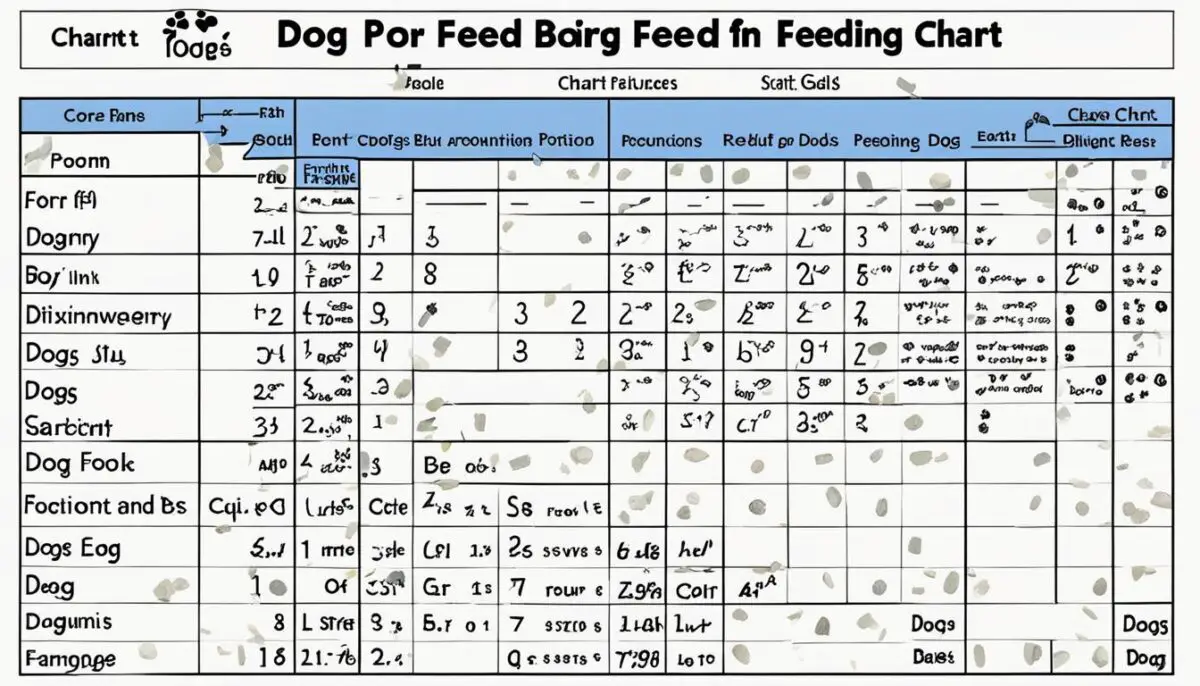Feeding your dog the right amount of food is essential for their health and well-being. Overfeeding or underfeeding can lead to various health complications. Factors such as the dog’s age, weight, and activity level should be considered when determining the amount of food to feed. It’s important to choose a quality dog food brand that uses natural ingredients. The feeding chart provided on the dog food packaging can serve as a guide but may need to be adjusted based on individual factors.
The Importance of Serving Size
When it comes to feeding your dog, the importance of portion size cannot be overstated. The quantity of food your dog consumes plays a vital role in their overall health and well-being. Both overfeeding and underfeeding can lead to a range of health complications that can impact your dog’s quality of life.
“Proper portion control is essential to maintain your dog’s health.”
Overfeeding your dog can have serious consequences. It can result in weight gain, which can lead to difficulty breathing, joint problems, and a shorter lifespan. Excessive weight places added strain on your dog’s internal organs, potentially leading to heart failure and an increased risk of certain cancers.
On the other hand, underfeeding your dog can also have detrimental effects. It can cause weight loss, leaving your dog malnourished and weak. Insufficient food intake can result in a weakened immune system, making your dog more susceptible to illness and infections. Additionally, underfeeding can lead to skin and coat issues, as well as gastrointestinal problems.
The Right Balance
It’s crucial to strike the right balance when it comes to serving size. Feeding your dog a nutritionally balanced diet with complex, human-quality ingredients can help ensure they receive the essential nutrients they need to thrive. Paying attention to your dog’s feeding guidelines, considering factors such as age, weight, and activity level, is key to determining the appropriate portion size.
By providing your dog with proper portion sizes, you can help them maintain a healthy weight, promote optimal organ function, and support their overall well-being.
| Health Complications of Overfeeding | Health Complications of Underfeeding |
|---|---|
|
|
Factors That Affect What Type of Food to Feed Your Dog
When it comes to choosing the best type of food for your dog, several factors should be taken into consideration. These factors include their age, weight, activity level, and the quality of the dog food brand you choose. By considering these aspects, you can ensure that your furry friend receives the proper nutrition they need to thrive.
Age
Just like humans, dogs have different nutritional requirements at different stages of their lives. Puppies, for example, require food that is specially formulated for their growing bodies. Puppy food contains higher amounts of protein and certain vitamins and minerals that promote healthy development. On the other hand, senior dogs may benefit from a senior formula that addresses their specific needs, such as joint health and weight management.
Weight
The weight of your dog plays a crucial role in determining the type of food they should consume. Overweight dogs may benefit from a weight management formula that is designed to help them shed pounds in a healthy way. These formulas are often lower in calories and fat, while still providing the necessary nutrients. Conversely, underweight dogs may require a high-calorie diet to help them gain weight and build muscle.
Activity Level
The activity level of your dog is another important factor to consider when choosing their food. Dogs with high activity levels, such as working or sporting dogs, require a diet that is higher in calories to sustain their energy needs. On the other hand, less active dogs may require a calorie-restricted diet to prevent weight gain. It’s essential to strike the right balance between energy intake and expenditure to keep your dog healthy and thriving.
Choosing a Quality Dog Food Brand
Choosing a high-quality dog food brand is vital for your dog’s overall health. Look for brands that use natural, wholesome ingredients and avoid fillers and artificial additives. It’s also a good idea to consult with your veterinarian for recommendations on reputable dog food brands that meet the nutritional needs of your specific dog breed.
To summarize, factors such as age, weight, activity level, and choosing a quality dog food brand all play a significant role in determining the best type of food for your furry companion. By considering these factors and consulting with your veterinarian, you can provide your dog with a nutritionally balanced diet that supports their overall health and well-being.
Factors That Determine the Amount of Food to Feed Your Dog
When it comes to feeding your dog, there are several factors that you need to consider in order to determine the right amount of food. These factors include exercise, weight, metabolic rate, number of meals per day, and the type of food they consume. To ensure your furry friend stays healthy and maintains an ideal weight, it’s important to take these factors into account.
Exercise
The amount of exercise your dog gets plays a significant role in determining their food intake. Dogs that are highly active and engage in regular physical activities require more calories to fuel their energy needs. On the other hand, dogs with a sedentary lifestyle or lower activity levels may require fewer calories. Adjusting the amount of food based on your dog’s exercise routine can help prevent weight gain or loss.
Weight
Weight is another crucial factor that affects the amount of food to feed your dog. Dogs that are overweight or obese may need a reduced portion size to help them shed excess pounds. Conversely, dogs that are underweight or have a fast metabolism may require a slightly larger portion to maintain a healthy weight. Regularly monitoring your dog’s weight and adjusting their food accordingly can help keep them in optimal condition.
Metabolic Rate
The metabolic rate of your dog determines how efficiently they burn calories. Dogs with a high metabolic rate tend to burn calories faster and may require a larger portion size to meet their energy needs. On the other hand, dogs with a slower metabolic rate may need a smaller portion to avoid weight gain. Understanding your dog’s metabolic rate can help you determine the appropriate amount of food to feed.
Number of Meals Per Day
The number of meals per day also plays a role in determining the amount of food to feed your dog. Most adult dogs thrive on two meals per day, while puppies may require three or more smaller meals to fuel their growth. Additionally, dividing the total daily portion into multiple meals can help prevent overeating and aid in digestion. Consult with your veterinarian to determine the best meal frequency for your dog’s specific needs.
Type of Food
The type of food your dog consumes can impact their nutritional needs and portion size. Different types of dog food, such as dry kibble, wet food, or raw diets, have varying caloric densities and nutrient compositions. It’s important to follow the feeding guidelines provided on the packaging of your chosen dog food brand and adjust the portion size accordingly. Your veterinarian can assist you in selecting the right type of food for your dog’s specific dietary requirements.
By considering these factors and referring to the dog feeding chart provided on the packaging of your chosen dog food brand, you can ensure that your furry companion receives the appropriate amount of food to support their overall health and well-being.

Dog Food Feeding Chart
When it comes to feeding your dog, it’s important to know the right amount to give them. Dog food brands provide a feeding chart on their packaging to help guide you through the process. This chart offers guidelines for the amount of food to feed based on your dog’s weight, ensuring they receive the appropriate nutrition. Let’s take a look at a sample feeding chart for dogs of different weights:
| Dog Weight | Feeding Amount |
|---|---|
| 3 – 6 lbs | ⅓ to ½ cup per serving |
| 7 – 20 lbs | ¾ to 1 ½ cups per serving |
| 21 – 50 lbs | 1 ½ to 3 cups per serving |
| 51 – 100 lbs | 3 to 4 cups per serving |
| Over 100 lbs | 4 ½ cups + ¼ cup for every additional 10 lbs |
It’s important to note that every dog is unique, and their feeding requirements may vary. Factors such as age, activity level, and metabolism can all influence the amount of food they need. Use the feeding chart as a starting point and adjust the amounts based on your dog’s specific needs. Monitor their weight and body condition regularly, and consult with your veterinarian if you have any concerns.

Frequency of Feeding
Veterinarians recommend establishing a regular feeding schedule for dogs to ensure their nutrition and overall health. The frequency of feeding depends on factors such as the dog’s age and energy levels.
For adult dogs, it is generally recommended to provide two meals a day—one in the morning and one at night. This allows for better digestion and helps maintain a steady energy level throughout the day. By dividing the food into two servings, you can also monitor your dog’s eating habits more effectively.
Puppies, on the other hand, have higher energy needs due to their rapid growth and development. They typically require three or more feedings per day. Consult with your veterinarian to determine the exact feeding schedule for your puppy based on their age and breed.
Pregnant and lactating dogs also have specific dietary requirements. During pregnancy, it is essential to provide them with increased nutrition to support their puppies’ development. Your veterinarian can guide you on the appropriate feeding schedule and portion sizes during this stage.
Establishing a regular feeding schedule not only helps monitor your dog’s eating habits but also promotes digestive health and prevents accidents. Dogs thrive on routine, so try to feed them at the same time each day. Consistency and balance are key to keeping your dog healthy and happy.
| Age | Number of Meals per Day |
|---|---|
| Puppies (8-12 weeks old) | 3-4 |
| Puppies (3-6 months old) | 3 |
| Puppies (6-12 months old) | 2-3 |
| Adult Dogs | 2 |
| Pregnant Dogs | 3-4 |
| Lactating Dogs | 4-5 |
The table above provides a general guideline for the number of meals per day based on different life stages in dogs. However, it is essential to consult with your veterinarian to determine the right feeding schedule for your specific dog, considering their age, weight, and overall health.
Conclusion
Feeding your dog the right amount of food is crucial for their health and well-being. By considering factors like age, weight, activity level, and type of food, you can determine the appropriate portion size to meet their nutritional needs.
Following a dog feeding chart provided by your chosen brand can serve as a helpful guide. However, it’s essential to adjust the amounts based on your dog’s individual factors and consult with your veterinarian for personalized advice.
Establishing a consistent feeding schedule, with two meals a day for adult dogs and more frequent feedings for puppies, promotes digestion and helps prevent accidents. Your veterinarian can also guide you on the specific feeding requirements for pregnant, lactating, or senior dogs.
Remember, a well-balanced diet is key to maintaining your dog’s weight and overall health. So, be mindful of their portion sizes, monitor their eating habits, and provide them with quality, natural ingredients to support their well-being.
FAQ
How much should a dog eat a day?
The amount of food a dog should eat per day depends on factors such as age, weight, and activity level. It’s important to consider these factors and refer to the feeding chart provided on the packaging of your chosen dog food brand.
What are the health complications of overfeeding or underfeeding a dog?
Overfeeding a dog can lead to issues like difficulty breathing, shortened lifespan, heart failure, and certain cancers. Underfeeding can cause weight loss, skin and coat issues, gastrointestinal problems, and a weakened immune system.
What factors affect what type of food to feed a dog?
Factors such as age, weight, and activity level should be considered when choosing a dog food brand. Puppy food is necessary for growing puppies, while senior dogs may benefit from a senior formula. Different activity levels may require different calorie-heavy or calorie-restricted diets.
What factors determine the amount of food to feed a dog?
Factors such as exercise, weight, metabolic rate, number of meals per day, and the type of food being consumed should be taken into account when determining the amount of food to feed a dog.
Is there a dog food feeding chart available?
Yes, most dog food brands provide a feeding chart on their packaging that offers guidelines for the amount of food to feed based on your dog’s weight. It’s important to follow the feeding chart and adjust amounts based on your dog’s specific needs.
How often should I feed my dog?
Veterinarians recommend feeding adult dogs two meals a day—one in the morning and one at night. Puppies may require three or more feedings per day due to their high energy levels. Pregnant and lactating dogs have different feeding requirements, with specific guidelines for each stage.
What is the importance of proper dog feeding?
Feeding your dog the right amount of food is crucial for their health and well-being. Proper portion sizing and a balanced diet can help maintain your dog’s weight and overall health. It’s always recommended to consult with your veterinarian to ensure your dog’s specific nutritional needs are met.

